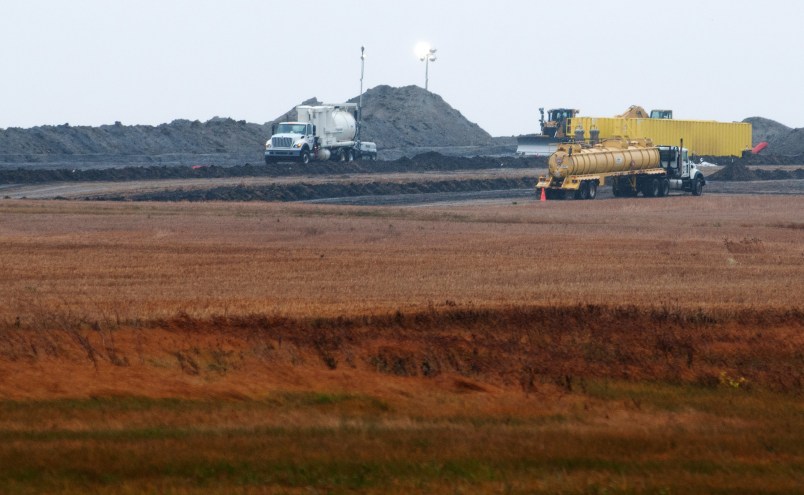BISMARCK, N.D. (AP) — North Dakota, the nation’s No. 2 oil producer behind Texas, recorded nearly 300 oil pipeline spills in less than two years, state documents show. None was reported to the public, officials said.
According to records obtained by The Associated Press, the pipeline spills, many of them small, are among some 750 “oil field incidents” that have occurred since January 2012 without public notification.
“That’s news to us,” said Don Morrison, director of the Dakota Resource Council, an environmental-minded landowner group with more than 700 members in North Dakota.
Dennis Fewless, director of water quality for the state Health Department, said regulators are reviewing the state’s policies for when to publicly report such incidents after a massive spill was discovered last month in northwestern North Dakota by a wheat farmer. State and company officials kept it quiet for 11 days — and only said something after the AP asked about it.
North Dakota regulators, like in many other oil-producing states, are not obliged to tell the public about oil spills under state law. But in a state that’s producing a million barrels a day and saw nearly 2,500 miles of new pipelines last year, many believe the risk of spills will increase, posing a bigger threat to farmland and water.
“We’re certainly looking at that now and what would be a threshold for reporting to the public,” Fewless said. Taking notice of the recent criticism, the state issued a statement Oct .17 on an estimated 7-barrel oil spill in Divide County, which borders Canada in far northwestern North Dakota.
The state also is mulling a better system to track spills in-house, Fewless said, from their origin to cleanup status.
“We really have to dig through our data base to get specifics,” said Fewless, adding that a more user-friendly tracking system for regulators may be developed.
Such a system would be valuable for the public, too, said Louis Kuster, who raises wheat near Stanley in northwest North Dakota. Farmers and ranchers rely on land for their livelihood, so information on spills that could threaten land or water supplies “absolutely is important for us to know,” he said.
Between coffee-shop talk and chatting with neighbors, nothing much happens around the fourth-generation farmer’s land without him knowing about it — except when it comes to oil spills.
“What you don’t know, nobody is going to tell you,” Kuster said.
Earlier this month, Kuster and his neighbors noticed truckloads of oil-tainted dirt being hauled away from an adjacent farm. It was allegedly from a broken pipeline, but no one really knows for sure, he said.
“We have no idea how big the spill is and why it happened,” he said. “I’d try to get more information from the state but I’m too busy getting my harvest in.”
North Dakota officials have urged pipeline industry to officials to quickly — and safely — expand the network to keep pace with record production in the oil patch. The state has about 17,500 miles of pipelines, including the addition last year of 2,470 miles, roughly the distance from New York City to Los Angeles.
For almost two weeks, no one knew about a break in a Tesoro Corp. pipeline that was discovered Sept. 29 in a remote area near Tioga. Officials say no water was contaminated or wildlife hurt, but the spill was one of the largest in North Dakota’s history, estimated at 20,600 barrels. Oil oozed over an area the size of seven football fields.
Records obtained by the AP show that so far this year, North Dakota has recorded 139 pipeline leaks that spilled a total of 735 barrels of oil. In 2012, there were 153 pipeline leaks that spilled 495 barrels of oil, data show. A little more than half of the spills companies reported to North Dakota occurred “on-site,” where a well is connected to a pipeline, and most were fewer than 10 barrels. The remainder of the spills occurred along the state’s labyrinth of pipelines.
“The public really should know about these,” Morrison with the landowner group said. “If there is a spill, sometimes a landowner may not even know about it. And if they do, people think it’s an isolated incident that’s only happening to them.”
North Dakota also had 291 “incidents” this year that leaked a total of about 2,209 barrels of oil. Data show that all but 490 barrels were contained and cleaned up at the well site. In 2012, there were 168 spills reported that leaked 1,089 barrels of oil; all but 376 barrels were contained on site, data show. Only one incident — a crash involving an oil truck last year — was reported publicly.
Department of Mineral Resources director Lynn Helms — the state’s top oil regulator — said regulators worry about “over-reporting” spills. The goal, he said, is to find a balance to so that “the public is aware of what’s happening but not overwhelmed by little incidents.”
Kuster believes most people would like to immediately know about even the smallest spill, because even a barrel of spilled oil likely could ruin water sources and take untold acres of cropland out of production. He also said timely, accurate and accessible information would hold companies and regulators accountable.
“It would tell me if there is enough oversight and why these accidents happen and if they could have been avoided,” he said. “Right now, you don’t know if there is a spill unless you find it yourself.”
___
Follow James MacPherson on Twitter at http://www.twitter.com/macphersonja
Copyright 2013 The Associated Press. All rights reserved. This material may not be published, broadcast, rewritten or redistributed.






